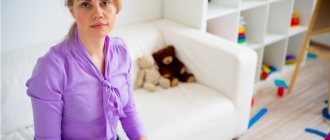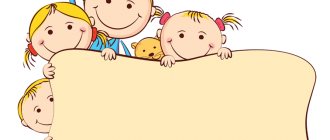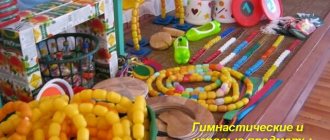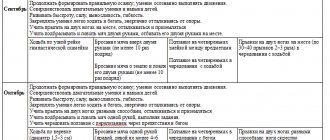Consultation for teachers “Non-traditional forms of work in physical education in preschool educational institutions”
Municipal budgetary preschool educational institution
"Kindergarten No. 16"
Consultation for teachers
“Non-traditional forms of work in physical education in preschool educational institutions”
Prepared by the teacher:
Belikova Yulia Anatolevna
Novorossiysk
2017
Non-traditional forms of work
in physical education at preschool educational institutions
In preschool age, the foundation of health is laid: the life systems and functions of the body mature and improve, its adaptive capabilities develop, its resistance to external influences increases, posture is formed, physical qualities and habits are acquired, and strong-willed character traits are developed, without which a healthy lifestyle is impossible.
Physical activity is the main source and motivating force for protecting and promoting health, improving the physical and intellectual abilities of a person. A child gets to know the world, masters speech, spatio-temporal connections of objects and phenomena with the help of movements; this is ingrained in him from preschool age. It is necessary to develop the physical culture of a preschooler, providing, first of all, for the formation of an attitude towards motor-active activity, interest and need for physical self-improvement, enjoying games, exercises, and activities. We introduce the child to physical education constantly, hourly, every minute. It permeates his entire life, all types of activities, recreation.
Currently, despite the variety of programs being implemented in preschool institutions, the problem of children's physical education remains relevant. This is confirmed by the trend of worsening health status and a decrease in the level of physical activity of preschool children. There is an increasing need, starting from a very early age, to ensure that preschoolers have a stable interest, the need for regular physical exercise, and the value of motivation for a healthy lifestyle. Physical education classes are dry, monotonous, and as a result of this, there is no interest or desire to engage in physical education. That is why the use of alternative physical education activities of a non-traditional orientation becomes especially important for preschool educational institutions. Non-traditionality implies a difference from the classical structure of the lesson through the use of new ways of organizing children, non-standard equipment, making some changes to the traditional form of structure of the lesson, leaving the main thing unchanged.
To do this, it is necessary to conduct classes in various options, in a non-traditional form: Olympiads, hikes, health days, travel, you need to give children the opportunity to improvise in classes. Using these techniques, classes turn out to be interesting, provide great emotional stress, and give children joy.
As a teacher, I am more interested in the question of what types of non-traditional health system can be presented in a preschool institution in addition to physical education classes.
- Technology for preserving and promoting health:
Rhythmic movements to music
. Movements in combination with words and music represent a holistic educational and developmental process: children are favorably influenced by the tempo, rhythm, dynamics of music and words, the arrhythmic pulsation with which the movements are associated causes a coordinated reaction of the whole organism.
Musical and outdoor games
- contain exercises used in almost all classes and are the leading activity of a preschooler. Here, techniques of imitation, imitation, figurative comparisons, role-playing situations, competitions are used - everything that is required to achieve the goal when conducting dance and play gymnastics classes.
Relaxation
is one of the ways to overcome internal tension, based on more or less conscious muscle relaxation. Even preschoolers living in the modern civilized world experience increased mental and physical stress; constant rush, anxiety, a flow of negative information from the television screen, frequent infectious diseases, fatigue, which subsequently leads to overexertion. By teaching children the relaxation method, we help them relieve internal muscle tension, calm down, thereby bringing the nervous system and psyche into a normal state of rest. Children’s ability to manage their feelings and emotions is another step towards developing their self-confidence.
Relaxation before bed - with
it is the body’s natural rest. It protects brain cells from exhaustion and destruction, restores energy expended during wakefulness. During sleep, all metabolic processes are normalized. Systematic lack of sleep leads to health problems, therefore, great importance should be given to organizing children’s sleep. You can use a calm melody for relaxation or recite the autogenic training formula in images, as well as use pendulums and scented pads.
Phytoncidotherapy.
Onion leaves and bulbs contain concentrated vitamins, mineral salts, nutrients and a large number of phytoncides that suppress the growth of pathogenic microorganisms. Each type of onion has its own medicinal properties and characteristics. The juice and gruel must be freshly prepared, because when exposed to air for 10–15 minutes, volatile bactericidal substances evaporate.
Garlic is a disinfecting, bacteria-killing medicinal plant. It is used in the treatment and prevention of many diseases.
Aroma - therapy and phyto - therapy
— nature is always ready to generously give a natural remedy for healing to both children and adults. For children who often suffer from acute respiratory viral infections, phytotherapy is recommended for general health improvement and increased immunity. Melissa, chamomile, calendula flowers, mint, oregano, St. John's wort - have anti-inflammatory effects. Rosehip, motherwort, chamomile, calendula, lemon balm - have restorative and sedative effects. Also, medicinal herbs are used for healing pads, which have soothing and bactericidal properties.
Finger gymnastics
- This section serves to develop manual skills, fine motor skills and hand coordination. Exercises, turning the learning process into an exciting game, not only enrich the child’s inner world, but also have a positive effect on improving memory, thinking, and developing imagination.
Breathing and sound gymnastics.
With the help of this gymnastics, the child’s overall vitality, resistance and resistance to colds increase. Children develop respiratory muscles, increase the mobility of the chest and diaphragm, and improve blood circulation in the lungs. This gymnastics restores impaired nasal breathing, has a positive effect on metabolic processes, corrects deformations of the chest and spine that have developed in the course of diseases, and improves the neuropsychic state.
Gymnastics for the eyes
- Helps relieve tension in the eye muscles during prolonged eye strain.
Health running (dosed)
– give children an emotional charge of vigor and spiritual balance; train breathing, strengthen muscles, bones, joints. Recreational running should be carried out with a small subgroup of children (5–7) people, taking into account the physical level of fitness of the children. In older preschool age, they run at an average pace (2.4–2.7 m/s) without stopping for significant distances - from 950 m to 1600 m - in a period of time from 5 to 11 minutes.
Pouring cold water
– promotes awakening of the nervous system, mobilization of the body’s internal forces. The dousing is usually carried out for 20–30 s. After it, the child quickly wipes himself dry.
Game stretching
— stretching exercises are imitative in nature and are performed during a role-playing game, consisting of interconnected game situations, tasks, and exercises. Selected in such a way as to help solve health and development problems. By imitating the image, the child begins to learn the technique of movements in sports and dance exercises, games, theatrical activities, etc. Imaginative and imitative movements develop creative, motor activity, creative thinking, motor memory, reaction speed, orientation in movement and space, and attention.
Orthopedic gymnastics
. The goal of orthopedic gymnastics is to strengthen the muscles of the arch of the foot in children through a set of special exercises.
- Healthy lifestyle training technology:
Game therapy (problematic-game activities).
Method of psychotherapeutic influence on children and adults using games. The game promotes the creation of close relationships between group members, relieves tension, anxiety, fear of others, increases self-esteem, allows you to test yourself in various communication situations, removing socially significant consequences.
A characteristic feature of the game is its two-dimensionality. Distinctive signs of the unfolding of the game are the rapidly changing situations in which the object finds itself after acting on it, and the equally rapid adaptation of actions to the new situation.
The goal of play therapy is to affirm the child’s unique “I” and self-worth; serve the interests of children.
Self-massage, acupressure.
Self-massage is an important means of physical education; it helps to expand the capillaries of the skin, accelerates blood circulation, enhances the functions of the glands, which has a positive effect on metabolism. Acupressure is pressing with fingertips on the skin and muscle layer at the location of tactile points and nerve branches. This type of massage gives good results in a gaming situation and by mentally pronouncing affectionate words. This element of psychophysical training helps to relax muscles and relieve neuro-emotional tension.
A set of exercises to develop fine motor skills of the hands
– these are games with sticks, octagonal pencils; drawing on grain, sand; rolling walnuts and stones in the palms; games using clothespins; games using sponges, pipettes; games using a dry pool (corks, cereals, small objects); balls with buttons; massage balls.
- Corrective technology:
Fairy tale therapy
- today fairy tale therapy is one of the main means of psychotherapeutic influence used to correct various mental processes and behavioral reactions of the child. This method of psychocorrection is based on the fact that a fictional story carries a hidden meaning in solving complex problems. Reading fairy tales helps a child overcome life's difficulties and find a way out of difficult situations.
Music therapy
is a medicine that is listened to. At the end of the last century, Russian physiologist I.R. Tarkhanov, with his original research, proved that melodies that bring joy to a person slow down the pulse, increase the strength of heart contractions, contribute to the dilation of blood vessels and normalize blood pressure, while irritating music gives the exact opposite effect. Music that is readily listened to stimulates the secretion of digestive juices and increases appetite. It was noticed that music acts selectively - depending not only on the character, but also on the instrument on which it is performed.
Playing the clarinet affects blood circulation. Violin and piano are the best for soothing. And the flute has the most relaxing effect.
The greatest effect of music is in the prevention and treatment of neuropsychiatric diseases. Music can calm, relax and activate, relieve sadness and cause an influx of energy, or even excite, create tension, cause aggressiveness. Music affects people more acutely than words.
Color therapy
– this is a healing color. Color has long been given a mystical meaning and a beneficial only negative effect on humans. Some flowers caress the eye, soothe, promote a surge of internal strength, others irritate and evoke not the best emotions. Some are invigorating, others are depressing. Moreover, they act this way on some, and differently on others. In short, the influence of color is selective.
Red color is useful for all inflammatory diseases, including smallpox and lupus. A patient suffering from them is placed in a room where everything is red, and all the rays penetrating here must be red.
Blue color has a special calming effect. Mental workers will find it easier to work in a room with a blue lamp or blue curtains on the windows. This is an excellent remedy for psychosis. And even the craziest maniacs will be overcome by the calming influence if their felt-lined riot room is illuminated with blue light. This color is also beneficial for weak eyes.
Green color is effective in treating eye inflammation. Orange sharpens the appetite. Yellow heals the intestines.
Laughter therapy.
Accelerates recovery, helps to cope with difficulties, and maintain peace of mind. They do not replace treatment, but serve as a strong and pleasant additional remedy. Laughter allows you to completely relax.
Training
- an element of mental discipline that can and should be taught to preschoolers, the ability to exaggerate the positive and dissolve, disperse the negative.
When performing trainings, it is important for children to be able to imagine the situation being described, which in turn gives them the opportunity to calm down, relieve excess stress and improve their mood.
Autotraining
– influence the subconscious by relaxing muscles, breathing, teaching how to relax. After physical activity, you need to sit in a chair, or lie down, isolated from extraneous noise, relax, and distract yourself from disturbing thoughts; breathe deeply and calmly.
Summaries of non-traditional physical education classes by age
Notes of non-traditional physical education classes
by age
Summary of a non-traditional physical education lesson in the second junior group “The kids have become little frogs”
Target:
to form motor skills in children, to develop psychophysical qualities.
Tasks:
1) improve crawling under an arc, jumping into a hoop from a hoop, imitating the movements of frogs, walking like a snake;
Equipment:
box, frog toy, 2 arcs, 6 pins, 3 hoops, ribbons, frog hats according to the number of children in the group.
Progress of the lesson
Come closer to me. I'll show you something. You often meet an unusual animal. It is on the path, sometimes jumps out on the path, looks at you with its bulging little eyes and tries to hide again in the wet grass. And sometimes he jumps so fast that you can’t catch up. And when “kva-kva” starts talking, everyone recognizes him by his voice. Guess who's in my box! (toy) That's right, frog! Admire how smooth and slippery his suit is. And what color is it! That's right, green. Did everyone get a good look at it? I will put the open box on the ground, let the little frog jump in the grass and tell the mother frog how he visited us. This is how the little frog jumps quickly. Wave your arms at him.
Now put on your frog hats. Ready! Everything is fine! Let's start practicing, we will repeat the movements of the frog and do everything beautifully.
We walked one after another in a circle with our “paws” - we bent our arms at the elbows and spread them in different directions, we raised them up, lowered them down and even rotated them.
Slowly we ran after each other, moving our paws through the air. So we run, we look under our feet
We stopped. “Paws” - arms extended forward, turn them around, look at them on one side, on the other, clap your hands
They ran after each other again, faster, with their paws bent at the elbows and clapping their palms at the top.
They stopped, put their paws on my cheeks, turned their heads lightly to the side, and that’s it, everyone looked at me carefully
Open it wide, inhale, take in a lot of air and close your mouth. Now we calmly release it through the nose.
Warm-up with seaweed (bands).
Well done, “little frogs”! Everything was done well. Can I complete the next task? Of course yes! Then we’ll all say “kwa, kwa, kwa!”
We’ll crawl under the arches, and when we straighten up, we’ll say, “kwa, kwa.” And now to jump from hoop to hoop, we also say “kwa, kwa.” Walk in a “snake” between the pins.
Everyone walked the difficult path; They didn’t hit anything, they managed to do a lot, even more than the frog. For this you are entitled to a gift - a game. And it's called "Frogs"
MAGAZINE Preschooler.RF
“Non-traditional forms of physical education and health work with preschoolers”Education Department of the Belgorod City Administration Municipal Budgetary Preschool Educational Institution Child Development Center - Kindergarten No. 75
“I’m not afraid to repeat again and again: caring for health is the most important work of a teacher. Their spiritual life, worldview, mental development, strength of knowledge, and self-confidence depend on the cheerfulness and vigor of children.”
V.A. Sukhomlinsky.
The priority area of work of the preschool institution is to preserve and strengthen the health of children.
Job objectives:
- To form in the child a position of recognition of the value of a healthy lifestyle;
- To promote the comprehensive development of the necessary skills of coordination of movements, the ability to navigate in society;
- Develop practical skills and abilities to perform hardening procedures.
Work principles
- Availability
- Systematicity and consistency
- Visibility
- Dynamism
- Differentiation
Expected results of work
- The knowledge and skills acquired by the child will allow them to solve a whole range of strengthening and maintaining health without medication.
- The acquired skills will help satisfy their need for movement and stabilize emotions, teach them to control their body, develop not only physical, but also mental and creative abilities, moral qualities, etc.
- The experience gained will strengthen various muscle groups, relieve fatigue, and create a state of psychophysiological comfort.
- Conditions for the full physical development of preschool children
- Gym with necessary and sufficient equipment, sports equipment
- Sports ground that meets modern requirements
- Creating a health-preserving and developmental environment that promotes the development of healthy lifestyle options
- Forms of conducting physical education and recreational activities in preschool educational institutions
GCD for the implementation of the educational field "Physical Education"
- Morning exercises
- Outdoor games
- Gymnastics after sleep
- Sports holidays
Joint activities of the teacher with children on the topics:
- "Strengthen your health"
- "I'll help myself"
- “We want to be healthy”
- "Journey to the Country of Zdravushka"
- "Rainbow of Health"
- “Both hardening and playing”
- "Journey to Planet Health"
- “I take care of my health”
- “To the forest kingdom for health”
Working with parents and teachers. Systematic and systematic interaction between parents, children, teachers and medical workers
In modern society, a priority of health must be created, which is formed in the minds of people, starting from preschool age!
Since 1991, the preschool educational institution has practiced improving the health of children using the natural forces of nature: air, sun, water.
Currently, the kindergarten has organized a circle “Morzhonok” , “Grow healthy baby!” , "We
walruses! in different age groups. The number of walruses is 54 people (15% of
total number of children in preschool educational institutions). The “walruses” missed 1.6 days due to illness, which indicates the effectiveness of non-traditional recovery.
We decided to experience for ourselves what is in Nature. After all, a person should not be afraid of anything: the heat comes - we are with it, the cold comes - we come to him...
How I became a “Walrus” ... Reflections of children - walruses
The people envy them - They don’t get colds, The bitter cold is not scary for them, But quite the opposite.
But we advise you not to envy the walruses, but to shower yourself with cold water in the morning!
Life in the 21st century presents us with many new problems, and the most pressing today is the problem of maintaining health.
A person must earn his own health and not rely on medicine. After all, being healthy is happiness!
Nature loves the person who loves her with his soul and heart!
The earth is a living current, you can not only walk on it barefoot, but also run, play...
Physical activity is crucial for a growing body
How often do we repeat: “Movement is life . But movement is also great joy!
... Both in drawing, in music, and in movement, a child lives a special life! It has been proven: satisfying the need for movement is the most important condition for the comprehensive development and upbringing of a child!
HAVE YOU HEARD ABOUT WATER? THEY SAY SHE IS EVERYWHERE! We see clouds, we hear thunder, everything around has gone dark... We are walking through puddles,
We are not afraid of rain and thunder!
For children, the most important thing is cold water. The cold releases a health hormone into the body!
Let us wash, splash, douse ourselves and bathe in the tub and in the bathhouse, always and everywhere... ETERNAL GLORY TO WATER!
On May 13, “Walruses” opened the swimming season in the kindergarten pool on the street.
Become and take your place in NATURE. It is not occupied by anyone and is not bought for any money, but only by one’s own deeds and work in Nature, for one’s own benefit and to make it easier for you!
| Next > |





